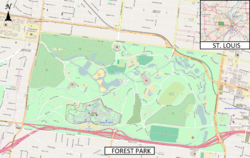 | |
 Missouri History Museum | |
| Established | 1866 |
|---|---|
| Location | St. Louis, Missouri, United States |
| Coordinates | 38°38′43″N90°17′17″W / 38.645252°N 90.287927°W |
| Public transit access | At Forest Park-DeBaliviere station |
| Website | mohistory.org |

The Missouri History Museum in Forest Park, St. Louis, Missouri, showcases Missouri history. It is operated by the Missouri Historical Society, which was founded in 1866. Museum admission is free through a public subsidy by the Metropolitan Zoological Park and Museum District.

